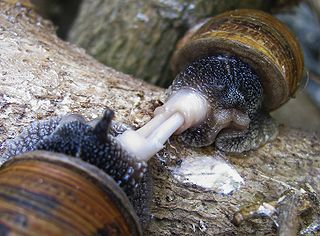Sex assignment is the discernment of an infant's sex, typically made at birth based on an examination of the baby's external genitalia by a healthcare provider such as a midwife, nurse, or physician. In the vast majority of cases (99.95%), sex is assigned unambiguously at birth. However, in about 1 in 2000 births, the baby's genitalia may not clearly indicate male or female, necessitating additional diagnostic steps, and deferring sex assignment.

A gender symbol is a pictogram or glyph used to represent sex and gender, for example in biology and medicine, in genealogy, or in the sociological fields of gender politics, LGBT subculture and identity politics.

XXY is a 2007 Argentine drama film written and directed by Lucía Puenzo and starring Ricardo Darín, Valeria Bertuccelli, Inés Efron and Martín Piroyansky. Based on the short story Cinismo (Cynicism), included in the book Chicos (Boys) by author Sergio Bizzio, the film tells the story of a 15-year-old intersex person, the way her family copes with her condition and the ultimate decision that she must eventually make as she struggles to define her own gender identity within a society that expects certain behaviors from every individual.

A hermaphrodite is a sexually reproducing organism that produces both male and female gametes. Animal species in which individuals are either male or female are gonochoric, which is the opposite of hermaphroditic.
Androgyny is the possession of both masculine and feminine characteristics. Androgyny may be expressed with regard to biological sex or gender expression.

Intersex people are individuals born with any of several sex characteristics, including chromosome patterns, gonads, or genitals that, according to the Office of the United Nations High Commissioner for Human Rights, "do not fit typical binary notions of male or female bodies".
Morgan Holmes is a Canadian sociologist, author, and a professor at Wilfrid Laurier University, Ontario. She is also an intersex activist and writer, and former member of Intersex Society of North America. Holmes participated in the first public demonstration by intersex people, now marked by Intersex Awareness Day.

Intersex, in humans and other animals, describes variations in sex characteristics including chromosomes, gonads, sex hormones, or genitals that, according to the UN Office of the High Commissioner for Human Rights, "do not fit typical binary notions of male or female bodies". Intersex is a part of nature and that is reflected in some representations of intersex in film and other media.

Intersex, in humans and other animals, describes variations in sex characteristics including chromosomes, gonads, sex hormones, or genitals that, according to the UN Office of the High Commissioner for Human Rights, "do not fit typical binary notions of male or female bodies".

Intersex, in humans and other animals, describes variations in sex characteristics including chromosomes, gonads, sex hormones, or genitals that, according to the UN Office of the High Commissioner for Human Rights, "do not fit typical binary notions of male or female bodies".

The following outline offers an overview and guide to LGBTQ topics:

Stevonnie is a fictional character in the animated series Steven Universe and Steven Universe Future, created by Rebecca Sugar. A "fusion" of the protagonist Steven Universe and his friend Connie Maheswaran, Stevonnie has the appearance of an androgynous young adult. First introduced in the episode "Alone Together", Stevonnie only appears occasionally in the series and once in the limited epilogue series, Steven Universe Future.

Intersex, in humans and other animals, describes variations in sex characteristics including chromosomes, gonads, sex hormones, or genitals that, according to the UN Office of the High Commissioner for Human Rights, "do not fit typical binary notions of male or female bodies". Intersex people were historically termed hermaphrodites, "congenital eunuchs", or even congenitally "frigid". Such terms have fallen out of favor, now considered to be misleading and stigmatizing.

Intersex people are born with sex characteristics, such as chromosomes, gonads, or genitals that, according to the United Nations Office of the High Commissioner for Human Rights, "do not fit typical binary notions of male or female bodies".

Intersex people are born with sex characteristics, such as chromosomes, gonads, or genitals and secondary sex characteristics that, according to the UN Office of the High Commissioner for Human Rights, "do not fit typical binary notions of male or female bodies".

The following is a timeline of intersex history.

Intersex people in the United States have some of the same rights as other people, but with significant gaps, particularly in protection from non-consensual cosmetic medical interventions and violence, and protection from discrimination. Actions by intersex civil society organizations aim to eliminate harmful practices, promote social acceptance, and equality. In recent years, intersex activists have also secured some forms of legal recognition. Since April 11, 2022 US Passports give the sex/gender options of male, female and X by self determination.

Intersex people in the United Kingdom face significant gaps in legal protections, particularly in protection from non-consensual medical interventions, and protection from discrimination. Actions by intersex civil society organisations aim to eliminate unnecessary medical interventions and harmful practices, promote social acceptance, and equality in line with Council of Europe and United Nations demands. Intersex civil society organisations campaign for greater social acceptance, understanding of issues of bodily autonomy, and recognition of the human rights of intersex people.
Non-binary or genderqueer is a spectrum of gender identities that are not exclusively masculine or feminine—identities that are outside the gender binary. Non-binary identities can fall under the transgender umbrella, since many non-binary people identify with a gender that is different from their assigned sex. Another term for non-binary is enby. This page examines non-binary characters in fictional works as a whole, focusing on characters and tropes in cinema and fantasy.








